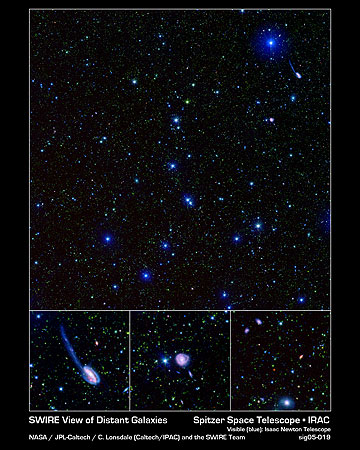| Spitzer Space Telescope | • Jet
Propulsion Laboratory • California Institute of Technology • Vision for Space Exploration |
|
| Home | Images | Newsroom | Features | About Spitzer | Search / Site Info |

| Images from Spitzer — Chronological — By Subject Artist Conceptions Video/Animation — Chronological Launch Images Satellite & Hardware Background Graphics Facilities Image Use Policy |
A SWIRE Picture is Worth Billions of YearsThese spectacular images, taken by the Spitzer Wide-area Infrared Extragalactic (SWIRE) Legacy project, encapsulate one of the primary objectives of the Spitzer mission: to connect the evolution of galaxies from the distant, or early, universe to the nearby, or present day, universe. The larger picture (top) depicts one-sixteenth of the SWIRE survey field called ELAIS-N1. In this image, the bright blue sources are hot stars in our own Milky Way, which range anywhere from 3 to 60 times the mass of our Sun. The fainter green spots are cooler stars and galaxies beyond the Milky Way whose light is dominated by older stellar populations. The red dots are dusty galaxies that are undergoing intense star formation. The faintest specks of red-orange are galaxies billions of light-years away in the distant universe. The three lower panels highlight several regions of interest within the ELAIS-N1 field. The Tadpole galaxy (bottom left) is the result of a recent galactic interaction in the local universe. Although these galactic mergers are rare in the universe's recent history, astronomers believe that they were much more common in the early universe. Thus, SWIRE team members will use this detailed image of the Tadpole galaxy to help understand the nature of the "faint red-orange specks" of the early universe. The middle panel features an unusual ring-like galaxy called CGCG 275-022. The red spiral arms indicate that this galaxy is very dusty and perhaps undergoing intense star formation. The star-forming activity could have been initiated by a near head-on collision with another galaxy. The most distant galaxies that SWIRE is able to detect are revealed in a zoom of deep space (bottom right). The colors in this feature represent the same objects as those in the larger field image of ELAIS-N1. The observed SWIRE fields were chosen on the basis of being "empty" or as free as possible from the obscuring dust, gas, and stars of our own Milky Way. Because Earth is located within the Milky Way galaxy, there is always a screen of Milky Way objects blocking our view of the rest of the universe. In some places, our view of the larger universe is less obscured than others and for the most part is considered "empty." These are prime observing spots for astronomers interested in studying objects beyond the Milky Way. ELAIS-N1 is only one of six SWIRE survey fields. The full survey covers 49 square degrees of the sky, equivalent to the area covered by about 250 full moons. The SWIRE image is a 3-channel false-color composite, where blue represents visible green light (light that would appear to be blue/green to the human eye), green captures 3.6 microns, and red represents emissions at 8 microns. To download, choose your preferred resolution and file format below. "High-Resolution" files will always the highest resolution and widest crop available, intended for print. Other resolutions are provided for convenient on-screen viewing. Screen-Resolution (360x450) JPEG (48 KB)
Individual Images
The Spitzer Space Telescope is a NASA mission managed by the Jet Propulsion Laboratory. This website is maintained by the Spitzer Science Center, located on the campus of the California Institute of Technology and part of NASA's Infrared Processing and Analysis Center. |




